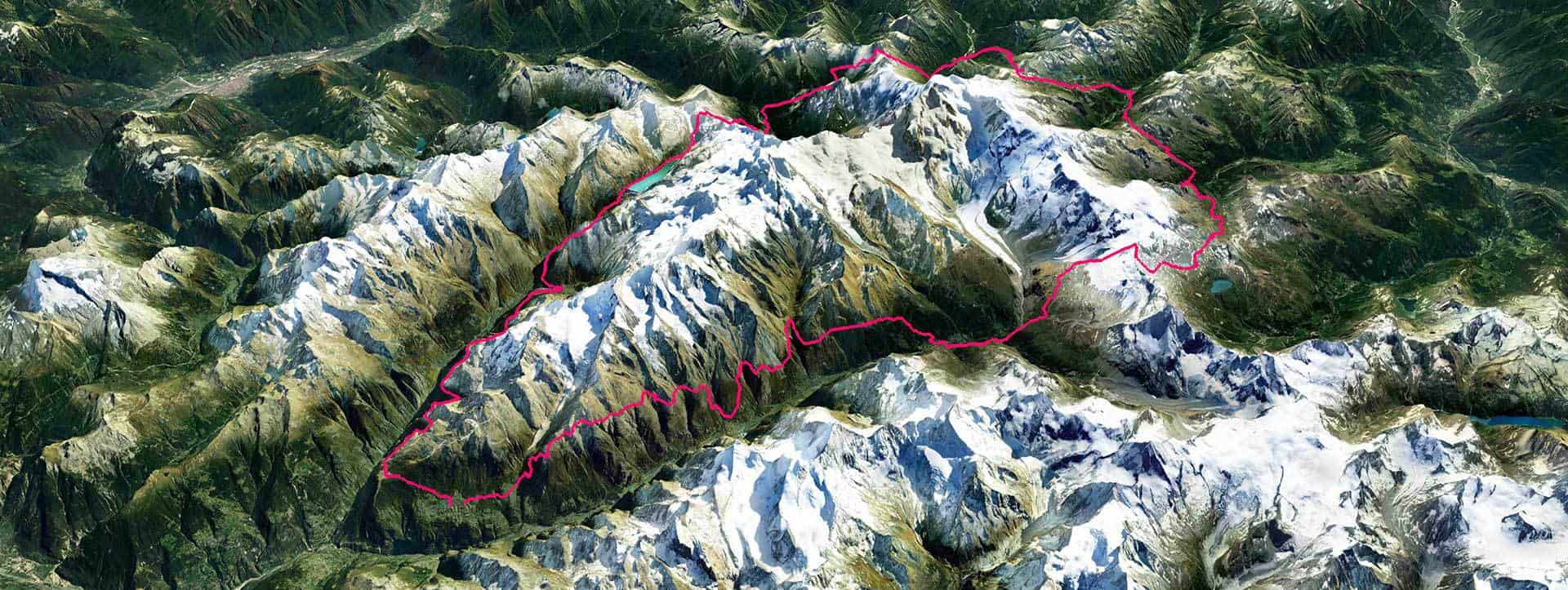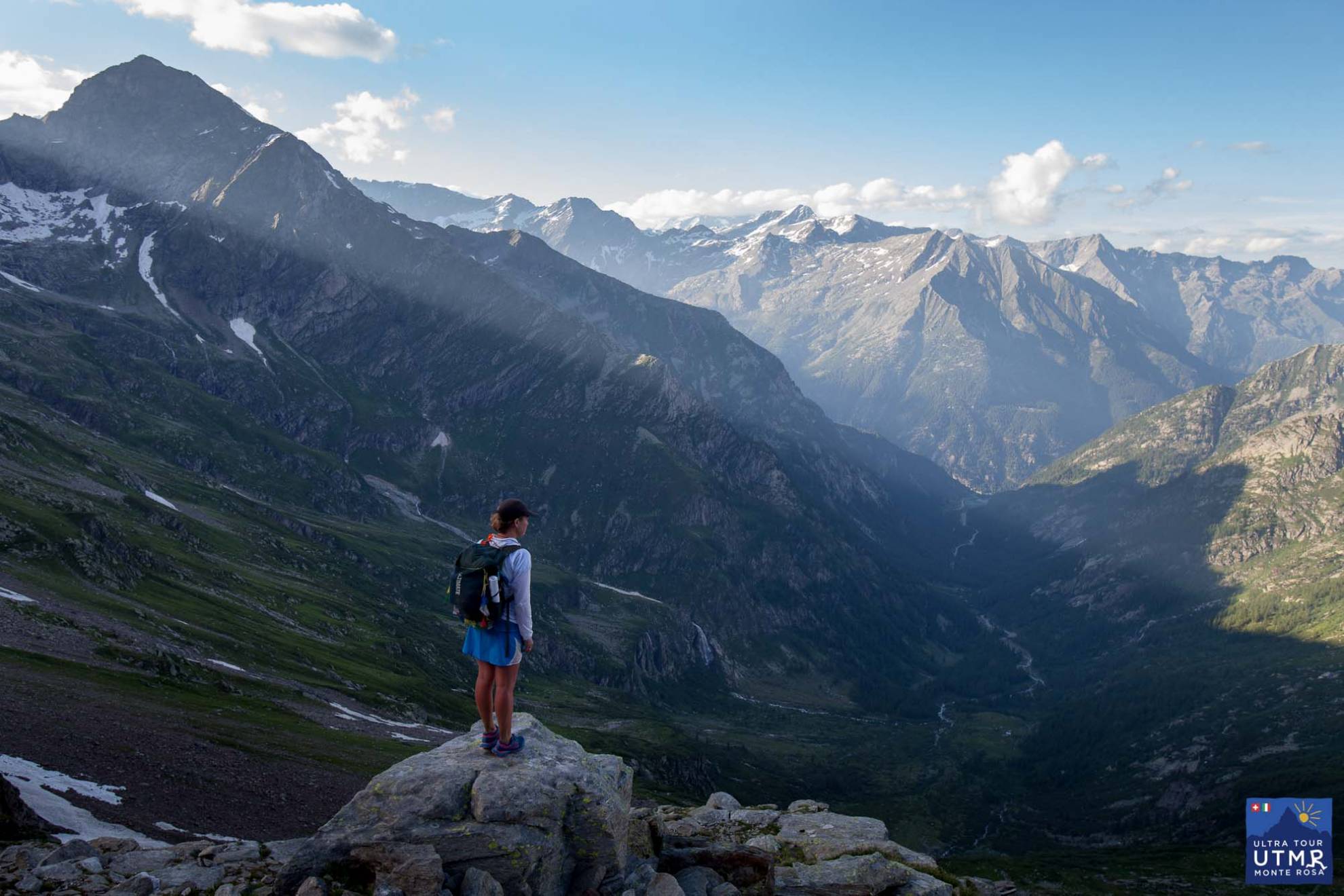
Juli 02
<

On 29th July 2016, Lizzy Hawker completed a full tour of Monte Rosa solo, to „test the course“. Here is what she wrote back then in answer to five questions about the route.
You started at the same time as the race will start next year, so passed around the route as a mid pack runner would. What should they look out for – what are the major challenges the Monte Rosa course will present to them?
A mid-pack runner will reach the top of the first climb out of Grächen and be onto the high balcony path of the Europaweg as dawn breaks. On this FKT I was alternately under and within a bank of cloud. But if it is clear then the alpenglow on the Weisshorn before sunrise will be something special to see. This balcony path runs across spectacular wild terrain high above the valley floor.
The major challenges of the route are just the relentless ascents and descents, the exposure to alpine conditions (the weather at 3300m might not be the same as low in the valley) and the isolation of some stretches of the route.
What difference does it make to do this distance and elevation change alone without the support of race infrastructure?
The full tour is pretty tough, whether racing or making an FKT. But there are a few differences. Firstly, when doing an FKT there is no support if something goes wrong or if you make a misjudgement. You have to be confident that you can rely on your own ability and experience. The Alps are not a true wilderness area, of course, but you still have to be confident with your level of risk. Then, food and drink can be a challenge. I made a foot trip around the race route the week before my FKT because I had some meetings with the mountain guides and some other logistics to fix. I took the opportunity to hide a couple of things under rocks and leave a few bags with friends along the way. I think I deposited three pairs of socks and a miscellaneous variety of food in plastic bags. It wasn’t very thought through, just a last ditch attempt to prepare in case I did try the FKT. In the event, I didn’t pick up some of the stuff, thinking I’d be quicker just using the local shop/coop, and much of the food I’d deposited wasn’t really what I felt like eating after X tough hours on foot.
In Alagna I was lucky a friend waited until 11pm to meet me. And in Macugngaga a hard night meant I passed through at breakfast time instead of during the dead hours of 3-4am. However you put it, when you make a ‚more-or-less‘ unsupported FKT you have to be running well enough within your comfort zone that you can make choices and decisions. You have to be able to look after yourself and push yourself onwards, otherwise everything falls apart. Conversely when you make the same journey within a race situation, yes the route is just as difficult, but there is infrastructure in place to support you.
What was the hardest part of the 37 hours for you and why?
The hardest part of the 37 hours for me was the night. Training since Lavaredo has been all or nothing and sleep has been insufficient. So whereas in the past I have comfortably gone through two nights and then had a tough time with the third nightfall, this time the first (only) night was difficult. That and getting myself out of the door to begin with to start the journey with no witness and no reason why other than curiosity.
What is your prediction for the fastest elite men and women’s times for 2017?
30-32 hours for the women, 26-30 hours for the men
What one piece of advice would you give to someone consider entering for the 2017 ultra?
Don’t arrive short on sleep! This does of course depend on family and work commitments but starting with a sleep deficit will make the night hours extra tough. You need to be well trained but well rested. Beyond that the only thing I would say is enjoy it. It is a wild and beautiful mountain journey and it will push you further than you think is possible, physically, mentally, emotionally.
Sep. 28
<

UPDATE: Lizzy completed in 37 hours 10 minutes
The climb is more than Everest from sea to summit, and fortunately the distance is much shorter than bay of Bengal to Everest’s top. But the comparatively short 169km on mountain trails with over 11,000m of climb and descent, all at an average altitude of around 2200m, is going to feel very long. Especially alone.
After three Everest Base Camp to Kathmandu “mail runs” (319km, 62 hours), a tour of the Annapurna circuit (circa 220 km, crossing a 5400m pass), the Manaslu Circuit (162 km, 5160m pass), and a recent birthday ~120km turn around the ring of hills around the Kathmandu Valley in Nepal, Ultra Tour Monte Rosa race director Lizzy Hawker is well practiced in this genre of attempting Fastest Known Times (FKT), or Only Known Times, or simply long, hard solo journeys with little sleep that, realistically, few other people are capable of doing.
At the time of writing, Hawker is eight hours into her run and hike, according to her tracking device, she’s on the long hike up from Zermatt to Theodul pass at 3300m. In clear weather, the view towards the Matterhorn is a treat. The view away from the Matterhorn is a treat too for that matter.
Views aside, why is she doing this? “I need to have done this myself a couple of times before I can send people out to do it for themselves,” she says, adding, “albeit in an easier context of a race – aid stations, security, dropbags, supporters and co-runners etc.”
Hawker has probably completed the Tour of Monte Rosa more times than anybody else.
“Yes, you can say I’ve done it many times over two long days [as UTMB training], and more recently as a training camp in four days, but this is the first nonstop attempt.”
Beyond this, to make arrangements for the race, she has found it easier just to go on foot and take cable cars to visit the race’s guides, checkpoint teams and hoteliers. To drive to each checkpoint one by one would take 17 hours (857 km) or 13 hours (636 km) for this year’s shorter 116 km course starting in Cervinia.
Regardless of this experience on the Monte Rosa trails and experience of ultra long foot journeys, Hawker says, “I’m actually surprisingly apprehensive given the number of times I’ve run that distance, run through the night etc. it’s the not knowing what my body and mind are going to do, or how I will react or deal with it. I’m kind of caught between the known and the unknown. I know the route so well, but doing it in one go without support is something different.
“The [period] before is harder, once started then everything else falls away and it’s just a journey. It’s nice to focus on something, to make a journey from start to finish and kind of suspend the everyday.”

If she completes it without problems, then she says, “as a bonus it will make a soft target for next year’s competitors to go for!” She will also be able to judge how demanding a challenge it is. It is harder than the tour of Mont Blanc, given the greater elevation change, longer climbs and the more technical trails. “I’ve estimated it will take runners 20% longer to complete,” says Hawker.
There are many things that could thwart the non-stop goal of course, bad weather being one. Another is a very busy race director’s inbox as the next race approaches, just five weeks away.
Follow Lizzy on her Open Tracking page. Information about the 2017 Ultra Tour Monte Rosa will be available in early September. Join the mailing list to stay informed.

Kommentar verfassen